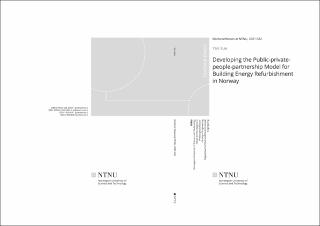| dc.description.abstract | Building energy refurbishment reduces energy consumption by increasing energy efficiency through technical installations. The potential for saving energy is huge, as the building sector accounts for 40% of the total global energy consumption. At the same time, building energy refurbishment often requires different types of partners, such as government institutions, construction companies, financing companies, consulting companies, as well as citizens, to support the investment, construction, and management. To respond to this complexity, partnership models which receive different resources are required. Hence, the overall objective of the thesis is developing a suitable partnership model to promote the building refurbishment market in Norway, thereby reducing the energy consumption, with particular focus on Norway.
However, there is a lack of analyses and comparison studies among the various modes of partnerships, making it difficult to choose the appropriate one for a specific project, which is crucial to its success. Furthermore, there are many residential buildings have low levels of energy efficiency and require refurbishment, which is currently not being done. Therefore, understanding the barriers in building refurbishment for the residentials, investors, and public sectors is important. But there is little information concerning the barriers from each sector’s perspective. Finally, there is a lack of analyses about how the existing partnership models promote the market, as well as a suitable partnership model to overcome the barriers in a specific context. In order to solve these problems, the thesis proposes three main research questions (RQ): 1) what are the existing multi-sector partnerships models being given attention by academia and in practice in the context of sustainable energy development, and what are their differences 2) what are the main barriers and solutions for conducting refurbishment from the perspective of people, private, and public sector 3) what is the most suitable partnership model to promote the market, and how to apply and improve it to be more practical to the market.
To answer the main objective and research questions, the research methods applied were literature review, interview, and workshop. The literature review was first conducted to summarize and analyze the history and status of multi-sector partnerships, which can provide a guide when choosing a suitable partnership model. Another review was conducted on the barriers for conducting refurbishment to figure out the barriers from the perspectives of people, private, and public. This can provide a more complete picture of the barriers. A third literature review was applied to figure out the current state of the existing business models in building refurbishment. Interviews were then conducted to verify the barriers found in the literature review, and find potential solutions based on empirical data. After a public-private-people partnership (PPPP) model was proposed to promote the refurbishment market, interviews were also conducted to determine the proposed model’s ability to overcome the barriers. Finally, the feasibility of the PPPP model was discussed in a workshop with representatives from each sector, and the model was improved to be more suitable for application using input from the participants.
Five main modes of multi-sector partnerships were identified, “multi-stakeholder partnership”, ‘public-private partnership’, ‘community-organizational partnerships’, ‘end-user-oriented partnerships’, and ‘public-private-people partnership’. Their differences are explained through four aspects, ‘factors affecting participation’, ‘relationship between participants’, ‘engagement strategy’, as well as ‘influence of participation’. The results of the literature review and the interviews for figuring out the barriers show that the main barriers are financial barriers, lack of information sharing and consulting, risk of not achieving desired benefits, limited resources, knowledge, experience, and lack of trust. Correspondingly, the potential solutions are financial support, an information sharing platform, and guarantees to cover the risks. In addition, the existing business models applied in the building refurbishment were identified and found to have limitations in terms of overcoming the barriers. The public-private-people partnership (PPPP) model was proposed, which has strong potential to overcome these barriers by dividing the high initial costs into more affordable sums, facilitating the information flow among different sectors, and having different resources, knowledge, and experiences from all three sectors to better handle the risks. At the same time, the interviews showed that most of the participants were interested in the PPPP model and would be able to provide the resources needed by the model. Finally, the detailed application of the PPPP model was explained with business model canvas, which developed through the workshop to be more suitable to the real market.
In the discussion section, areas of improvement of the different multi-sector partnership modes are regards as developing a systematic and effective way to classify the factors affecting participation into a structural system, exploring an efficient method to balance the power of different participants in the participation process, and finding an efficient means to make a collaborative agreement. Furthermore, how the PPPP model can overcome the barriers through a co-investment solution, information sharing platforms, co-creation of the detailed application with PPPP were discussed. At the same time, the limitations of PPPP model, such as being highly timeconsuming, the difficulty of engaging citizens, as well as the different communication levels were also mentioned.
A main contribution of the thesis is it identified and compared five modes of multisector partnerships, which is the first time in an urban development context. Another main contribution is identifying the barriers for building refurbishment from the angles of public, private, and people perspectives, which provides a fuller picture of the barriers. Most importantly, the thesis is the first to propose public-private-people partnership (PPPP) as a potential model to promote the building refurbishment market. For further study, it is recommended to study the PPPP model from the perspective of different countries. In particular, more information on the barriers and potential solutions in other countries is needed. Finally, the PPPP model needs to be tested throughout the lifecycle of a real project. | |

